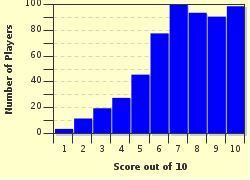Quiz Answer Key and Fun Facts
1. The conviction for murder and manslaughter of two scholars in 1209 led to the flight from the UK's oldest university town to establish the English-speaking world's second oldest university. Which town had the scholars fled from and where did they set up their new academic establishment?
2. The death of England's first Tudor monarch in 1509 led to the ascent to the throne of his second son and one of the country's most feared and iconic leaders. Which king took the throne and ruled for the next 38 years?
3. The arrival of a ship called the "Duke" in February 1709 ended more than four years of solitary living for a sailor who possibly provided the inspiration for Daniel Defoe's "Robinson Crusoe". Who was the Scottish sailor, immortalised by poet William Cowper, who had lived on the deserted Juan Fernandez islands for all this time?
4. Established in parklands in a western suburb of London in 1759, this site was inscribed in 2003 as a UNESCO World Heritage Site. Containing such highlights as the Nash conservatory, the Pagoda and the Orangery, what is the name of this popular visitor attraction?
5. Struck for the first time in May 1859, the Great Bell in the Westminster Clock Tower broke within three months of its debut. It was out of action for three years, but once back in working order it chimed every hour until silenced during World War I in 1916. By what name is this bell more commonly known?
6. In 1884, some twenty-six years after it had first been mooted as a project, the first part of this dictionary was published. Covering only words from A to Ant, the last sections were finally completed some 44 years later. Considered the most comprehensive compendium of the English language, which dictionary celebrated the 125th anniversary of its first publication in 2009?
7. In 1909, just six years after the first powered flight was achieved at Kitty Hawk, this man claimed the aviation prize offered by "The Daily Mail" by undertaking the first successful powered flight across the English Channel. In so doing, he completed the first powered flight across a large body of water in a heavier-than-air craft. Who was he?
8. 1934 saw the passing of three of the greats of nineteenth and twentieth-century English musical composition. Between them they gave the world such masterpieces as "The Planet Suite", "The Enigma Variations" and "Brigg Fair (An English Rhapsody)". Which of the following was NOT one of the musical legends who passed away in this year?
9. In August 1959, the brainchild of Alec Issigonis rolled off British production lines for the first time. Soon recognised as a design classic, the first models were built by BMC as the Austin Seven. The name by which they became universally known was introduced in 1961 along with a sport version made by the Cooper Car Company. What was this British classic that was relaunched by BMW in 2003?
10. At three in the morning of October 12th, 1984, a bomb exploded in the Grand Hotel, where the leading members of the British Conservative Party were staying during their annual party conference. Five people were killed but the chief target, Prime Minister Margaret Thatcher, and her cabinet survived. In which seaside city, a favoured destination amongst all UK political parties, did the blast take place?
Source: Author
Snowman
This quiz was reviewed by FunTrivia editor
bloomsby before going online.
Any errors found in FunTrivia content are routinely corrected through our feedback system.

